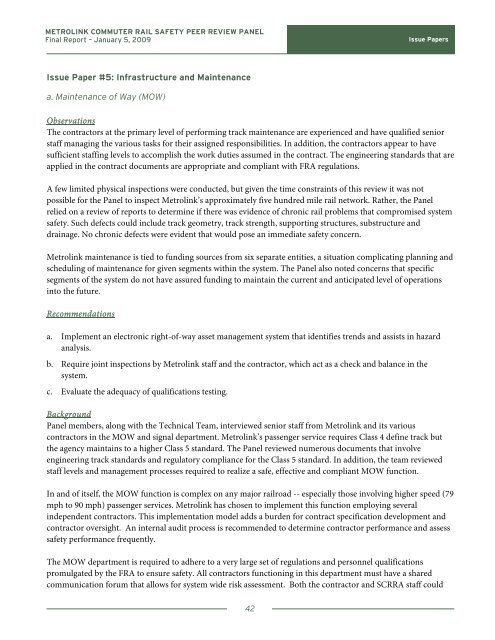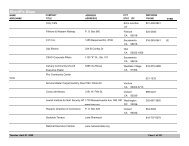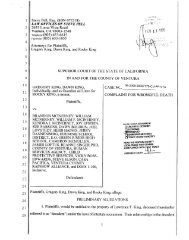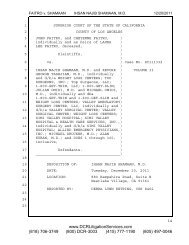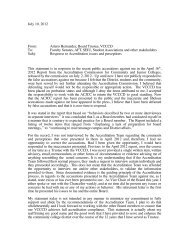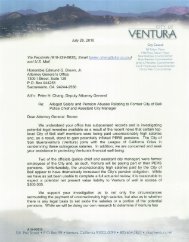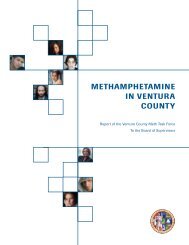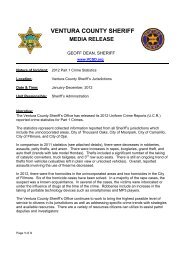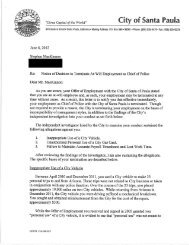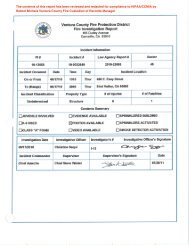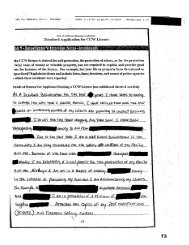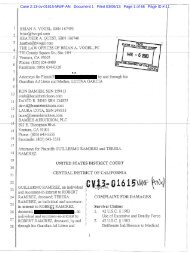Metrolink peer review report - Ventura County Star
Metrolink peer review report - Ventura County Star
Metrolink peer review report - Ventura County Star
Create successful ePaper yourself
Turn your PDF publications into a flip-book with our unique Google optimized e-Paper software.
METROLINK COMMUTER RAIL SAFETY PEER REVIEW PANEL<br />
Final Report – January 5, 2009<br />
Issue Paper #5: Infrastructure and Maintenance<br />
a. Maintenance of Way (MOW)<br />
Issue Papers<br />
Observations<br />
The contractors at the primary level of performing track maintenance are experienced and have qualified senior<br />
staff managing the various tasks for their assigned responsibilities. In addition, the contractors appear to have<br />
sufficient staffing levels to accomplish the work duties assumed in the contract. The engineering standards that are<br />
applied in the contract documents are appropriate and compliant with FRA regulations.<br />
A few limited physical inspections were conducted, but given the time constraints of this <strong>review</strong> it was not<br />
possible for the Panel to inspect <strong>Metrolink</strong>’s approximately five hundred mile rail network. Rather, the Panel<br />
relied on a <strong>review</strong> of <strong>report</strong>s to determine if there was evidence of chronic rail problems that compromised system<br />
safety. Such defects could include track geometry, track strength, supporting structures, substructure and<br />
drainage. No chronic defects were evident that would pose an immediate safety concern.<br />
<strong>Metrolink</strong> maintenance is tied to funding sources from six separate entities, a situation complicating planning and<br />
scheduling of maintenance for given segments within the system. The Panel also noted concerns that specific<br />
segments of the system do not have assured funding to maintain the current and anticipated level of operations<br />
into the future.<br />
Recommendations<br />
a. Implement an electronic right-of-way asset management system that identifies trends and assists in hazard<br />
analysis.<br />
b. Require joint inspections by <strong>Metrolink</strong> staff and the contractor, which act as a check and balance in the<br />
system.<br />
c. Evaluate the adequacy of qualifications testing.<br />
Background<br />
Panel members, along with the Technical Team, interviewed senior staff from <strong>Metrolink</strong> and its various<br />
contractors in the MOW and signal department. <strong>Metrolink</strong>’s passenger service requires Class 4 define track but<br />
the agency maintains to a higher Class 5 standard. The Panel <strong>review</strong>ed numerous documents that involve<br />
engineering track standards and regulatory compliance for the Class 5 standard. In addition, the team <strong>review</strong>ed<br />
staff levels and management processes required to realize a safe, effective and compliant MOW function.<br />
In and of itself, the MOW function is complex on any major railroad -- especially those involving higher speed (79<br />
mph to 90 mph) passenger services. <strong>Metrolink</strong> has chosen to implement this function employing several<br />
independent contractors. This implementation model adds a burden for contract specification development and<br />
contractor oversight. An internal audit process is recommended to determine contractor performance and assess<br />
safety performance frequently.<br />
The MOW department is required to adhere to a very large set of regulations and personnel qualifications<br />
promulgated by the FRA to ensure safety. All contractors functioning in this department must have a shared<br />
communication forum that allows for system wide risk assessment. Both the contractor and SCRRA staff could<br />
42


